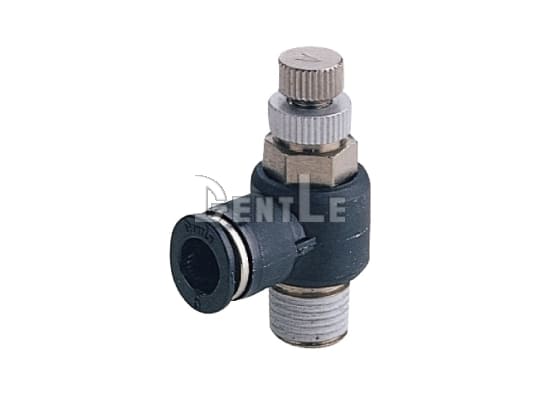What is a Pneumatic Flow Control Valve? Key Functions, Principles, and Applications Uncovered!
Have you ever wondered what a pneumatic flow control valve is and how it works? A pneumatic flow control valve is an essential component in any pneumatic system, designed to regulate the flow of air or other fluids, ensuring your system operates efficiently and reliably. In this article, we'll explore the key functions, operating principles, structure, and wide-ranging applications of pneumatic flow control valves, giving you a deeper understanding of their importance.
Table of Contents
What is a Pneumatic Flow Control Valve?
A pneumatic flow control valve, also known as a speed controller or flow controller, is a crucial part of many systems where fluid or air flow needs to be precisely controlled. These valves adjust the amount of air entering or exiting components, directly influencing the speed and efficiency of machinery. They come in two primary types: inlet control valves and exhaust control valves.
By regulating the airflow, pneumatic flow control valves help manage the speed and performance of systems like pneumatic actuators, machinery, and automation tools. They are widely used in various industries to ensure smooth and stable operation.

A flow control valve, also known as a speed controller, effectively regulates fluid flow through its valve core and valve seat.
Key Functions of a Pneumatic Flow Control Valve
- Flow Regulation: The core function of a pneumatic flow control valve is to regulate the flow of air or other fluids. By adjusting the gap between the valve core and seat, the valve precisely controls the flow, allowing the system to maintain the required output. This is especially useful in production environments where maintaining consistent flow is critical.
- Pressure Control: Pneumatic flow control valves help regulate pressure within the system. By reducing the passage area, they reduce fluid velocity and lower the pressure, which is essential in ensuring that pressure levels remain stable and that the system operates safely.
- Speed Control: These valve are commonly used in pneumatic systems to control the speed of actuators like cylinders and robotic arms. Adjusting the airflow to the actuators helps control their speed, ensuring precise movements, which is vital in tasks like assembly, packaging, and other automated processes.
- Backflow Prevention: Some specialized pneumatic flow control valves, like check valves, allow fluid to flow in only one direction. This prevents backflow, ensuring that the system remains free of contamination and operates safely by protecting sensitive components from reverse flow damage.
How Does a Pneumatic Flow Control Valve Work?
Operating Principle:
When the valve core moves toward the valve seat, the fluid passage area decreases, which lowers the flow rate and pressure. On the other hand, when the core moves away from the seat, the flow passage increases, boosting the flow rate and pressure. This enables precise control over the flow and pressure of the air or fluid passing through the system.
Structure:
A pneumatic flow control valve consists of several main components: the valve body, valve core, valve seat, and the adjustment mechanism. The valve body contains the fluid passage, and the valve core and seat work together to regulate the flow. The adjustment mechanism can be manual, pneumatic, or electric, depending on the application and control requirements.
Where Are Pneumatic Flow Control Valves Used?
Pneumatic flow control valves are widely used in modern industrial applications, particularly in automation. By controlling the flow of air and fluids, these valves help ensure the efficient operation of machinery and systems. Here are some of the most common applications:
- Robotic Arm Control: Pneumatic flow control valves are used to precisely control the movement of robotic arms in automated production lines. By adjusting the air pressure and flow, they allow for smooth, consistent movements, which is crucial in tasks such as handling, assembly, and packaging.
- Pneumatic System Speed Control: These valves are critical in controlling the speed of cylinders and pneumatic tools in manufacturing and other industrial processes. By regulating the airflow into and out of the cylinders, they ensure that equipment operates smoothly, efficiently, and with precision.
- Automated Production Line Control: In automated production lines, where various machines work together in sync, the precise control of flow is essential for maintaining the overall efficiency and stability of the process. Pneumatic flow control valves ensure that components such as conveyors, positioning modules, and robotic arms operate at the correct speed and in sync with the rest of the system.
- Sewing Machines and Textile Equipment: In industrial sewing machines and textile processing equipment, pneumatic flow control valves help regulate the flow of air, controlling the movement of machine parts like needles. This precise control is essential for ensuring the quality and efficiency of operations such as stitching and fabric handling.
Conclusion: Why Pneumatic Flow Control Valves Matter
In conclusion, pneumatic flow control valves play an indispensable role in industrial automation, offering flow regulation, pressure control, speed adjustment, and backflow prevention. These valves help maintain system stability and ensure that your equipment operates efficiently. As automation continues to evolve, the applications of pneumatic flow control valves will become even more widespread, making them an essential tool in optimizing performance and product quality.
Pneumatic flow control valves are key to the efficient operation of industrial systems. Understanding their functions, principles, and applications can help ensure you select the right valve for your system. Be sure to consult with experienced suppliers to choose the best pneumatic flow control valve that meets your specific needs.
Further Reading: